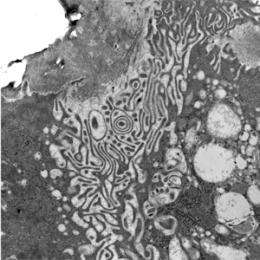Scientists identify proteins that direct bone demolition

(Medical Xpress) -- To keep the skeleton strong as the body ages, bones go through a process akin to urban renewal: Old structures are torn down and new ones built in their place.
Scientists at Washington University School of Medicine in St. Louis have identified four proteins that supervise bone demolition, directing the destructive work of cells known as osteoclasts. The finding will help efforts to prevent bone loss and weakening caused by osteoporosis, cancer and other conditions.
“We currently treat these disorders with drugs that inhibit osteoclasts,” says lead author Carl DeSelm, an MD/PhD student. “The ideal drug would slow down osteoclasts when they get out of control but still allow some breakdown so that renewed bone can be built in its place.”
The findings appear in Developmental Cell.
Age-related bone weakening likely results from an imbalance between the work of osteoclasts and other cells that rebuild bone. When they invade bones, breast cancers and other tumors bring osteoclasts with them to clear room for tumor growth, weakening the bones.
The proteins highlighted by the new study help cells manage resources in times of scarcity by breaking down and recycling parts of themselves. These autophagy (literally meaning “self-eating”) proteins also are targets for investigational drug therapies in cancer, irritable bowel disease and other conditions.
“Our findings suggest that we need to keep a close watch on the bones of patients as trials for those drugs move forward,” says co-author Steven L. Teitelbaum, MD, the Messing Professor of Pathology and Immunology. “These drugs inhibit autophagy proteins, which may block their activity in the skeleton, disrupting the renewal process and leaving patients with unusually fragile bones.”
Autophagy proteins have attracted interest in many different disciplines of biomedical research. The new study brings together the laboratories of Teitelbaum, who studies how the bones are renewed, and Herbert W. “Skip” Virgin IV, the Edward Mallinckrodt Professor and head of Pathology and Immunology, who investigates the immune system, chronic infections and autoimmune disorders.
“We study autophagy proteins because they alter the activity of cells in the lining of the intestine that are critical in Crohn’s disease,” Virgin says. “Mutations in some of these proteins have been associated with increased risk of this disease.”
Four years ago at a regular gathering of MD/PhD students, DeSelm was intrigued by news that Brian Miller, MD, PhD, then a graduate student in Virgin’s lab, worked with mice that lacked autophagy proteins in their myeloid cells. These cells originate in the bone marrow and produce the immune cells that Miller studies and the bone-demolishing osteoclasts that DeSelm studies.
When DeSelm looked at the bones and osteoclasts from the mice provided by Miller and observed unusual characteristics, Teitelbaum and Virgin decided to collaborate. The researchers disabled autophagy proteins in osteoclasts in test tubes and in animal models and found the osteoclasts couldn’t efficiently degrade bone.
“Normally, the osteoclast comes down on the bone and forms a gasket-like structure through which it secretes acids and other molecules that break down the bone,” DeSelm says. “When we disabled the autophagy proteins, the molecules that demolish bone didn’t go to the gasket.”
Instead, the demolition molecules landed in various locations along the surface of the cell and failed to degrade the bone. As a result, the bone could not be rebuilt.
Scientists now are conducting experiments to identify the proteins that help bone-degrading compounds cross the membranes of the osteoclasts. That knowledge could provide them with further options for controlling the renewal of bone, damping down osteoclasts when they get out of control in osteoporosis or cancer, but still allowing enough of their work to continue to renew the skeleton.
More information: DeSelm CJ, Miller BC, Zou W, Beatty WL, Meel Hv, Takahata Y, Klumperman J, Tooze SA, Teitelbaum SL, Virgin HW. Autophagy proteins regulate the secretory component of osteoclastic bone resorption. Developmental Cell, Nov. 3, 2011.















